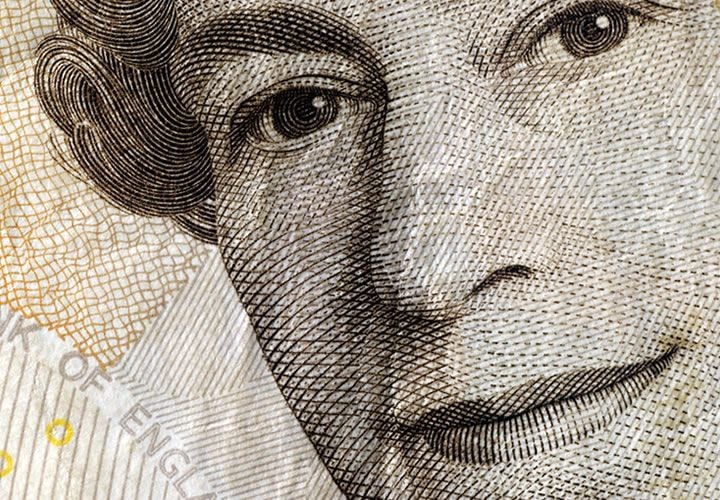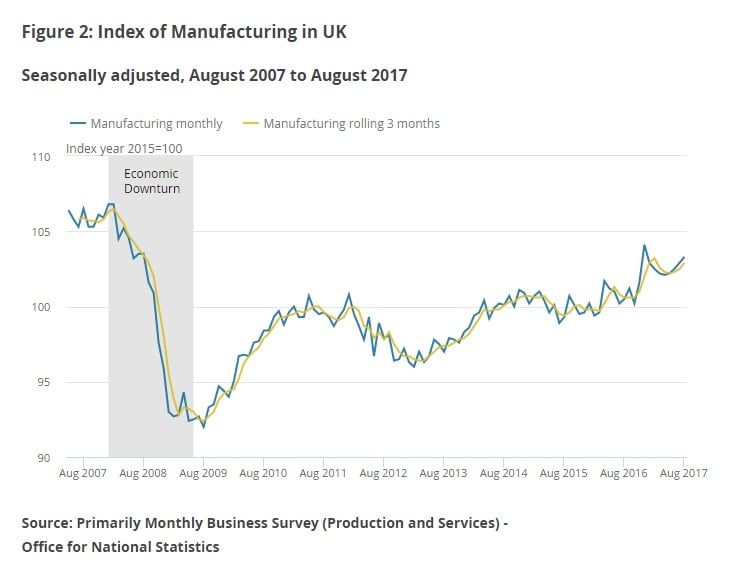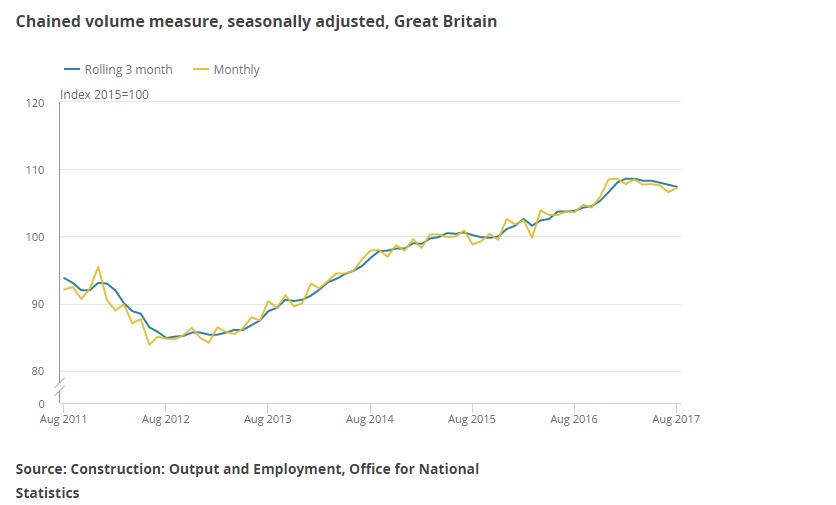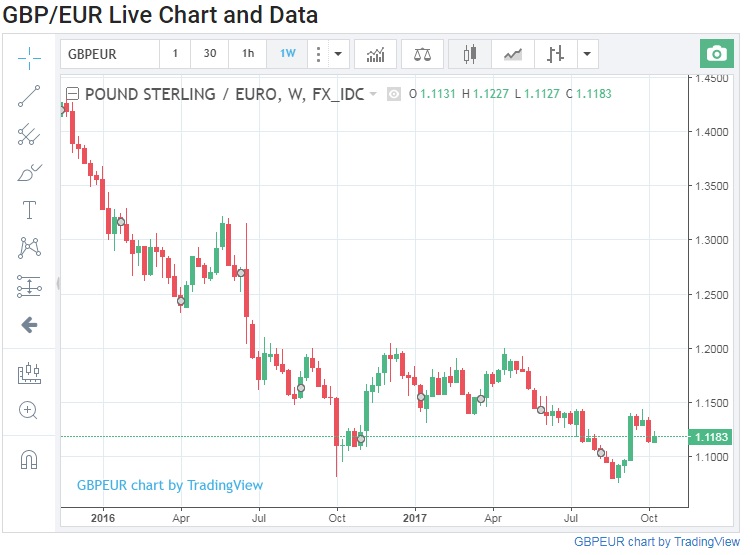British Pound Rises as Manufacturing Data Confirms UK Economy to End 2017 on a Stronger Note
- Written by: James Skinner
-

Stronger-than-expected industrial and manufacturing data adds weight to the view the Bank of England can safely raise interest rates in November.
The UK economy is purring on at a healthy rate according to the latest set of manufacturing, industrial and construction data from the Office for National Statistics.
The ONS reports manufacturing production grew by 0.4% month on month, twice the rate forecast by economists, which makes for an annual growth rate of 2.8%.
“The largest contribution to the rise in manufacturing in the three months to August 2017 came from other manufacturing and repair, which rose by 3.8%; this sub-sector includes a wide range of high-value milestone-based contracts for repair and maintenance, such as for aircraft, ships and boats,” says the ONS.

The Pound-to-Euro exchange rate was quoted at 1.1201 on the release of the data, having been as low as 1.1172 earlier in the day, and the Pound-to-Dollar exchange rate was at 1.3197 having been as low as 1.3130.
Total industrial production inched higher by 0.2% for the month, in line with estimates, after the solid manufacturing performance offset declines in mining and quarrying activity.
The data bodes well for overall UK economic growth rates heading into year-end.
"The deluge of official data for August provided reassurance that the economy has not lost pace in the third quarter and suggested that growth could even nudge up a touch," says Paul Hollingsworth, an economist at Capital Economics.
Also of note, construction output rose by 0.6% for the month, against expectations for an unchanged reading of 0% growth, defying the chorus of pessimistic voices that have dominated discussion around the industry in recent months.
“The month-on-month rise in all new work stemmed from growth in private housing, which grew 2.3% and infrastructure, which increased by 3.6%,” says the ONS.
August’s construction number is of note as it reflects actual production, so is hard data, for a month where sentiment-focused PMI surveys had shown the industry headed for recession.
September’s IHS Markit construction PMI showed the industry actually falling into recession, with the index dropping below the 50.0 no change level, although PMI surveys are often criticised for overreacting to changes in underlying economic activity. Only September's ONS construction data (due in November) will tell whether the sector really did feel the pinch.

“Q3 has shown solid enough progress as a whole, however May and her cabinet will look to see stronger results in the final months of the year to relieve pressure on the economy during these uncertain times,” says Dennis de Jong, managing director at UFX.com.
The news is good for the Pound, which is now tipped to increasingly focus on the intentions of Bank of England policy-makers, with markets expecting an interest rate rise in November. Tuesday's data suggests they may be able to raise rates by 0.25% without damaging the economy.
Expectations of higher rates can in turn fuel demand for Sterling from international investors, which is one reason why analysts at Bank of America raised their forecasts for the Pound this October.
Get up to 5% more foreign exchange by using a specialist provider by getting closer to the real market rate and avoid the gaping spreads charged by your bank for international payments. Learn more here.
Rising Wages
Manufacturing has seemed the only economic bright spot in the UK during recent months given the discussion around the construction industry and that optimism in the services sector has remained somewhat below the levels seen back in the Spring.
Economy watchers have been hoping the fall in the value of Sterling since the referendum would help to lift British industry out of a multi-decade stupor but economists are yet to be convinced that this is actually happening.
But Tuesday's stronger-than-expected industrial data comes one day after the ONS revised its estimates of unit labour costs higher, suggesting the outlook for wages is brighter than previously thought, which increases the odds of an interest rate hike from the Bank of England in November.
“With talk of a leadership contest and a new PM subsiding, sterling markets may refocus on the upcoming BoE policy meeting,” says Han-Ju Ho, an economist at Lloyds Bank.
The Bank of England is widely expected to raise interest rates at its November policy meeting, for the first time in a decade, as part of an effort to contain rising inflation.
“Policymakers’ assessment of capacity constraints means that a November interest rate rise is on the cards. The upward revision to unit labour cost figures yesterday (correcting an error by the ONS) only increases this likelihood,” says Ho.

The ONS announced Monday that it understated growth in unit labour costs during the second quarter, by error, and that employment costs actually rose at a rate of 2.4% during the period (up from the 1.6% earlier estimate).
“Stronger than expected unit labour cost growth and the recent material upward revision to the household savings rate has highlighted that the UK consumer is in better health than feared, which should help to ease concerns over a sharper economic slowdown in the year ahead,” says Lee Hardman, a currency analyst with MUFG.
The odds of the BoE pulling the trigger and “withdrawing stimulus” are solidifying in favour of a November move but exactly how high rates can go over the coming quarters remains to be seen.
“The market is now pricing a greater than 80% chance of the BoE hiking in November and has more than two hikes priced in by the end of 2018,” wrote Sebastien Cross, a strategist with Bank of America Merrill Lynch, in a recent note.
Further signals of a UK economic slowdown could see the Monetary Policy Committee adopt a more cautious tone on the economy at its coming meeting, even if it does also vote to reverse the August 2016 rate cut, although the odds of this happening appear to be fading in the wake of Monday's labour costs revision.
“We have currently pencilled in the first hike in November, and it would appear reasonable at the current juncture to expect another one or two hikes the following year, assuming that the UK is able to secure a transitional agreement with the EU for around two years,” says MUFG's Hardman.
Trade Balance Woes
Separately, ONS trade balance data showed the UK’s goods and services deficit with the rest of the world widening further than was expected in August - even after excluding volatile commodities from the comparison.
While the deficit widened to £13.2 billion for the three months to August, the ONS gave no detail on the goods or services categories behind the slump.



